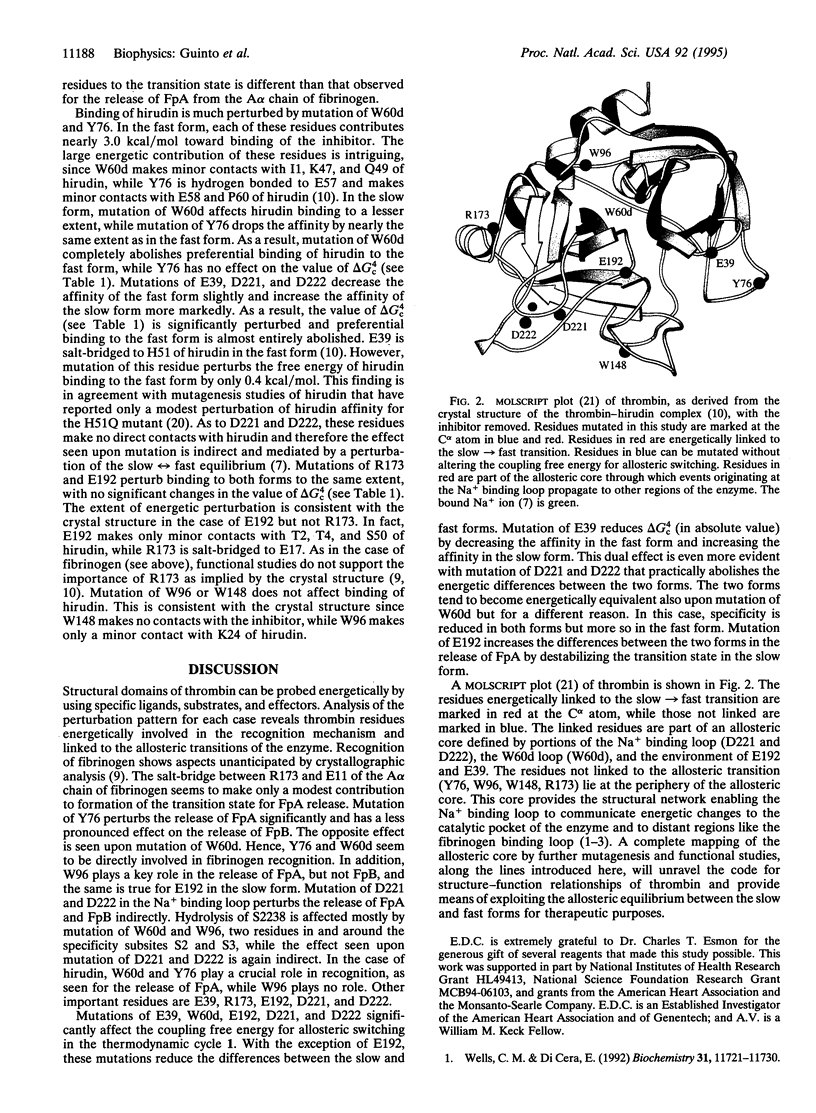Abstract
Residues energetically linked to the allosteric transition of thrombin from its anticoagulant slow form to the procoagulant fast form have been identified by site-directed mutagenesis. The energetics of recognition by the two forms of the enzyme were probed by using a synthetic chromogenic substrate, fibrinogen, and hirudin. The thrombin residues E39, W60d, E192, D221, and D222 are linked to the slow-->fast transition and are part of an "allosteric core" through which events originating at the Na+ binding loop propagate to other regions of the enzyme. The thrombin residues Y76, W96, W148, and R173 lie at the periphery of the allosteric core, affect recognition of fibrinogen and hirudin to the same extent in both forms, and are not linked to the slow-->fast transition.
Full text
PDF




Images in this article
Selected References
These references are in PubMed. This may not be the complete list of references from this article.
- Ayala Y., Di Cera E. Molecular recognition by thrombin. Role of the slow-->fast transition, site-specific ion binding energetics and thermodynamic mapping of structural components. J Mol Biol. 1994 Jan 14;235(2):733–746. doi: 10.1006/jmbi.1994.1024. [DOI] [PubMed] [Google Scholar]
- Bode W., Turk D., Karshikov A. The refined 1.9-A X-ray crystal structure of D-Phe-Pro-Arg chloromethylketone-inhibited human alpha-thrombin: structure analysis, overall structure, electrostatic properties, detailed active-site geometry, and structure-function relationships. Protein Sci. 1992 Apr;1(4):426–471. doi: 10.1002/pro.5560010402. [DOI] [PMC free article] [PubMed] [Google Scholar]
- Braun P. J., Dennis S., Hofsteenge J., Stone S. R. Use of site-directed mutagenesis to investigate the basis for the specificity of hirudin. Biochemistry. 1988 Aug 23;27(17):6517–6522. doi: 10.1021/bi00417a048. [DOI] [PubMed] [Google Scholar]
- Dang O. D., Vindigni A., Di Cera E. An allosteric switch controls the procoagulant and anticoagulant activities of thrombin. Proc Natl Acad Sci U S A. 1995 Jun 20;92(13):5977–5981. doi: 10.1073/pnas.92.13.5977. [DOI] [PMC free article] [PubMed] [Google Scholar]
- Di Cera E., Guinto E. R., Vindigni A., Dang Q. D., Ayala Y. M., Wuyi M., Tulinsky A. The Na+ binding site of thrombin. J Biol Chem. 1995 Sep 22;270(38):22089–22092. doi: 10.1074/jbc.270.38.22089. [DOI] [PubMed] [Google Scholar]
- Horovitz A., Fersht A. R. Strategy for analysing the co-operativity of intramolecular interactions in peptides and proteins. J Mol Biol. 1990 Aug 5;214(3):613–617. doi: 10.1016/0022-2836(90)90275-Q. [DOI] [PubMed] [Google Scholar]
- Kunkel T. A., Roberts J. D., Zakour R. A. Rapid and efficient site-specific mutagenesis without phenotypic selection. Methods Enzymol. 1987;154:367–382. doi: 10.1016/0076-6879(87)54085-x. [DOI] [PubMed] [Google Scholar]
- Le Bonniec B. F., Esmon C. T. Glu-192----Gln substitution in thrombin mimics the catalytic switch induced by thrombomodulin. Proc Natl Acad Sci U S A. 1991 Aug 15;88(16):7371–7375. doi: 10.1073/pnas.88.16.7371. [DOI] [PMC free article] [PubMed] [Google Scholar]
- Le Bonniec B. F., Guinto E. R., Esmon C. T. Interaction of thrombin des-ETW with antithrombin III, the Kunitz inhibitors, thrombomodulin and protein C. Structural link between the autolysis loop and the Tyr-Pro-Pro-Trp insertion of thrombin. J Biol Chem. 1992 Sep 25;267(27):19341–19348. [PubMed] [Google Scholar]
- Le Bonniec B. F., MacGillivray R. T., Esmon C. T. Thrombin Glu-39 restricts the P'3 specificity to nonacidic residues. J Biol Chem. 1991 Jul 25;266(21):13796–13803. [PubMed] [Google Scholar]
- Lord S. T., Byrd P. A., Hede K. L., Wei C., Colby T. J. Analysis of fibrinogen A alpha-fusion proteins. Mutants which inhibit thrombin equivalently are not equally good substrates. J Biol Chem. 1990 Jan 15;265(2):838–843. [PubMed] [Google Scholar]
- Naski M. C., Shafer J. A. Alpha-thrombin-catalyzed hydrolysis of fibrin I. Alternative binding modes and the accessibility of the active site in fibrin I-bound alpha-thrombin. J Biol Chem. 1990 Jan 25;265(3):1401–1407. [PubMed] [Google Scholar]
- Palmiter R. D., Behringer R. R., Quaife C. J., Maxwell F., Maxwell I. H., Brinster R. L. Cell lineage ablation in transgenic mice by cell-specific expression of a toxin gene. Cell. 1987 Jul 31;50(3):435–443. doi: 10.1016/0092-8674(87)90497-1. [DOI] [PubMed] [Google Scholar]
- Record M. T., Jr, Ha J. H., Fisher M. A. Analysis of equilibrium and kinetic measurements to determine thermodynamic origins of stability and specificity and mechanism of formation of site-specific complexes between proteins and helical DNA. Methods Enzymol. 1991;208:291–343. doi: 10.1016/0076-6879(91)08018-d. [DOI] [PubMed] [Google Scholar]
- Rydel T. J., Tulinsky A., Bode W., Huber R. Refined structure of the hirudin-thrombin complex. J Mol Biol. 1991 Sep 20;221(2):583–601. doi: 10.1016/0022-2836(91)80074-5. [DOI] [PubMed] [Google Scholar]
- Stubbs M. T., Oschkinat H., Mayr I., Huber R., Angliker H., Stone S. R., Bode W. The interaction of thrombin with fibrinogen. A structural basis for its specificity. Eur J Biochem. 1992 May 15;206(1):187–195. doi: 10.1111/j.1432-1033.1992.tb16916.x. [DOI] [PubMed] [Google Scholar]
- Wells C. M., Di Cera E. Thrombin is a Na(+)-activated enzyme. Biochemistry. 1992 Dec 1;31(47):11721–11730. doi: 10.1021/bi00162a008. [DOI] [PubMed] [Google Scholar]
- Zoller M. J., Smith M. Oligonucleotide-directed mutagenesis of DNA fragments cloned into M13 vectors. Methods Enzymol. 1983;100:468–500. doi: 10.1016/0076-6879(83)00074-9. [DOI] [PubMed] [Google Scholar]



